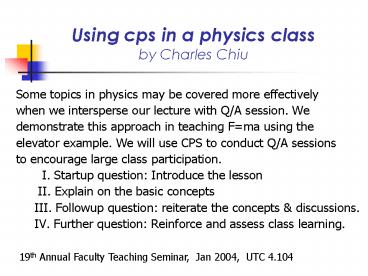Using cps in a physics class by Charles Chiu
1 / 11
Title:
Using cps in a physics class by Charles Chiu
Description:
Appeal to daily experience: Consider the experience in riding an elevator. ... Weight change: Put a bathroom scale between the man and the elevator floor. ... –
Number of Views:31
Avg rating:3.0/5.0
Title: Using cps in a physics class by Charles Chiu
1
Using cps in a physics classby Charles Chiu
- Some topics in physics may be covered more
effectively - when we intersperse our lecture with Q/A session.
We - demonstrate this approach in teaching Fma using
the - elevator example. We will use CPS to conduct Q/A
sessions - to encourage large class participation.
- I. Startup question Introduce the lesson
- II. Explain on the basic concepts
- III. Followup question reiterate the concepts
discussions. - IV. Further question Reinforce and assess class
learning.
19th Annual Faculty Teaching Seminar, Jan 2004,
UTC 4.104
2
I. Introduce the lesson Fma.
Appeal to daily experience Consider the
experience in riding an elevator. There is
weight changes which depend on the motion of
elevator.
3
Express familiar situation in more concise terms
of the lesson
- Weight Wmg. g is gravitational acceleration on
earth, g?10m/sec2 downward. - Units For a man with mass 50 kg, his weight is
W mg 50x10 N 50 kg-wt.
Units 1kg-wt10N. On a bathroom scale,
it would reads 50kg-wt. - Weight change Put a bathroom scale between the
man and the elevator floor. The apparent weight
is given by the scale reading S.
4
States of motion the corresponding scale
readings
Case-1 Moving with a constant acceleration to
have the velocity going from 0 to 10m/s. Let
scale reading be S1. Case-2 Moving at a constant
velocity 10m/s, scale S2. Case-3 Moving at
another const. velocity 20m/s, scale S3.
velocity (m/s)
S1 S2 S3
20
10
time
0
case-1 agt0 case-2a0 case-3a0
5
Ready for the startup-question How do scale
readings depend on the motion?
- A The higher the speed, the heavier the weight.
- S3gtS2gtS1gtW.
- B Initial acceleration gives a heavier feeling.
Then the higher the speed, the lighter weight. - S1gtW, S3ltS2.
- C There is the initial heavier feeling. But when
motion stays at a constant speed, the
scale-reading reverts back to W. S1gtW,
S2W, S3W. - D Apparent weight is only a "psychological"
concept. Three scale readings should all be
identical to original weight. - S1W, S2W and S3W.
6
II. Basic Concepts Visualize goings on using
free-body diagram
- Newton's second law of motion When a net force F
is applied to an object with m, the object will
move with an acceleration a. - Free body diagram. The sketch describes the
forces forces a involved. - The object is given by a dot labeled by m.
- Direction of a is indicated by an arrow.
- Forces on m are indicated by arrows, with F
F1F2 along direction of a. - Example When a is up, the length of S-arrow is
longer than that of mg-arrow.
Example case-1
S
a
m
mg
S-mgma SWma.
7
Solution to the startup question
- Freebody diagram gt SWma.
- Case 1 There is upward acceleration, i.e. a gt0
(acceleration), S1gtW. - Case 2 a0. This leads to S2W.
- Case 3, a0. It leads to S3W.
- So "C S1gtW, S2W, S3W is the correct choice.
8
Essential steps in using Fma
- Sketch a free body diagram with F1, F2,, m, a.
- Write down the equation ? F1 ? F2 ma.
- Each force along a has positive sign.
- Each force opposite to a has negative sign.
- Solve for the specific force in question.
9
III. A followup question (Full hints
Multi-level questions)
Multilevel questions The Extra gives better
students the opportunity to move ahead, while
waiting for others to complete the question.
Solution For the case a0.1g, Smg-ma0.9mg.
Hint Freebody Diag.
mg S ma
Class feedback Followup explanations and
discussions.
10
IV. A further question
- What would be the scale reading after the rope
- which suspends the elevator is broken?
- Hint After the rope is broken, the elevator
- will be accelerated downward with ag.
- With less hint. Further reinforce and assess
- the learning of the lesson. More discussions if
needed.
11
Summary
- I. Startup question (Q/A)
- It relates a familiar situation to the
lesson. - Expect the lesson will provide insights
to the answer. - II. Explanation on the basic concepts
- III. Follow-up question (Q/A)
- With full hints to reiterate key points
discussed. - Use two-level questions to involve the
whole class. - Class feed back more explanations.
- IV. A further question (Q/A)
- With less hints to reinforce the
learning of the lesson. - Objective assessment and more
discussions.































